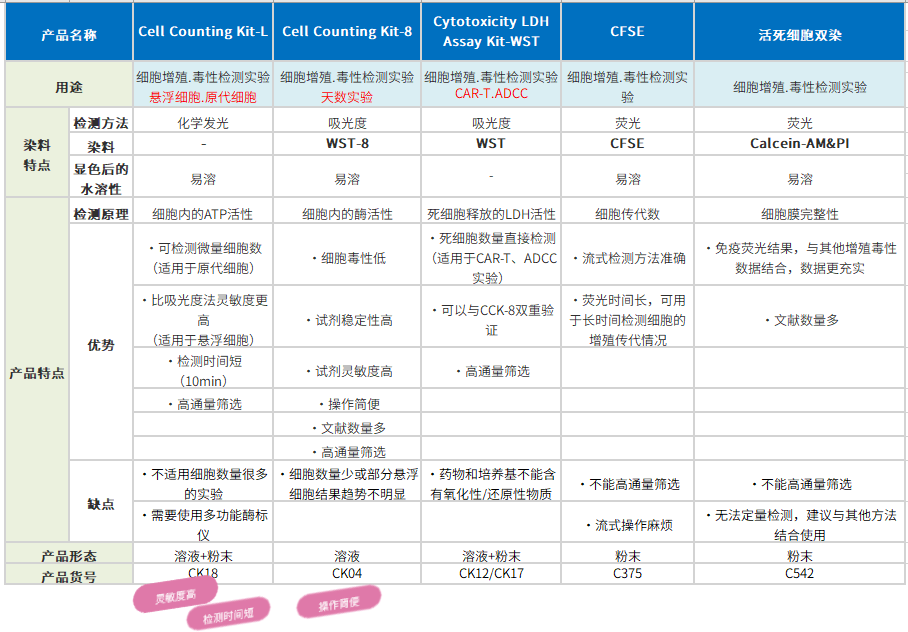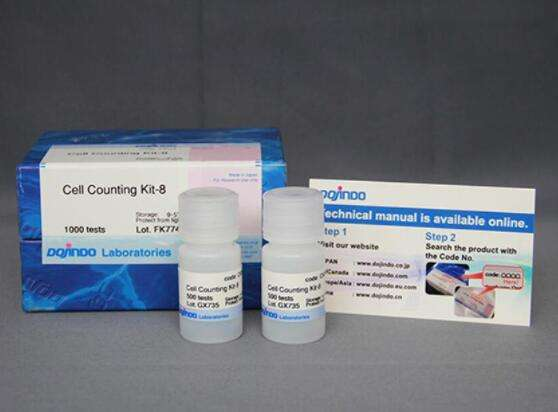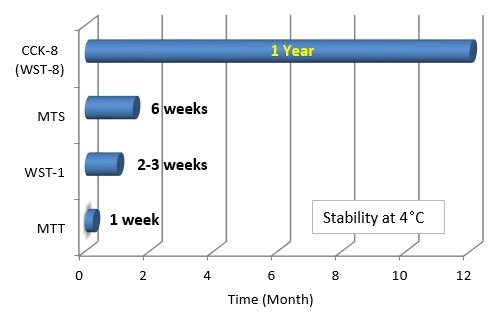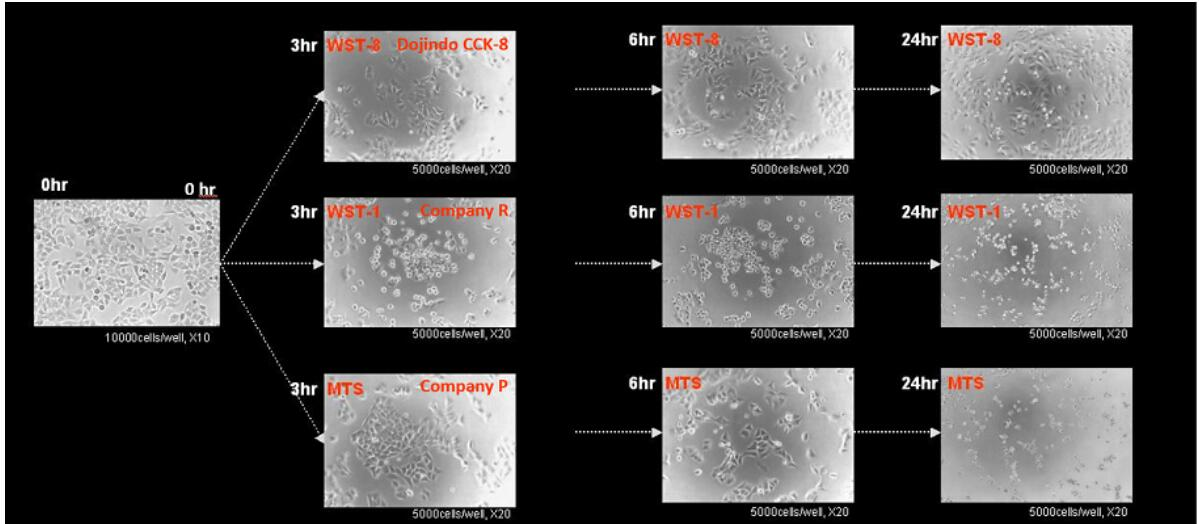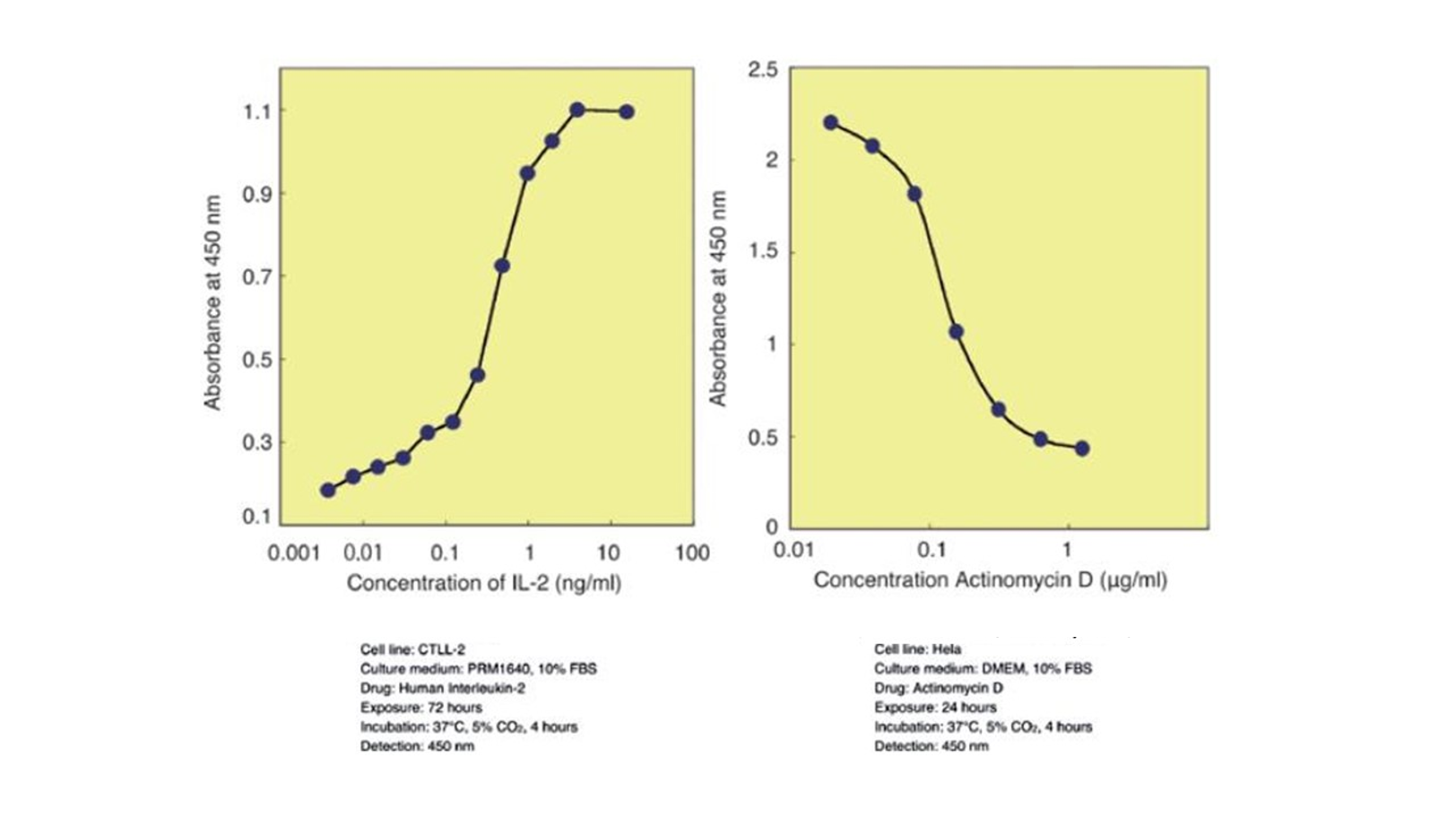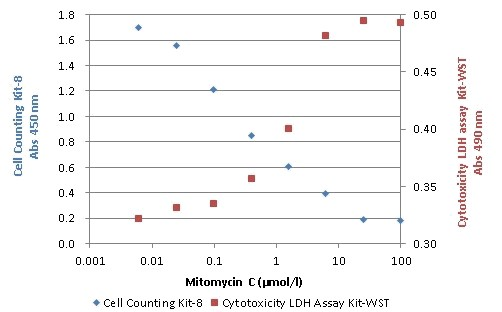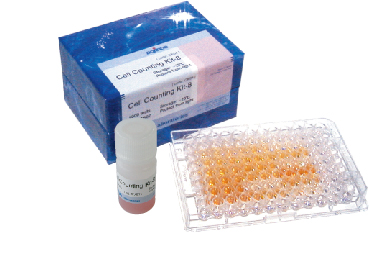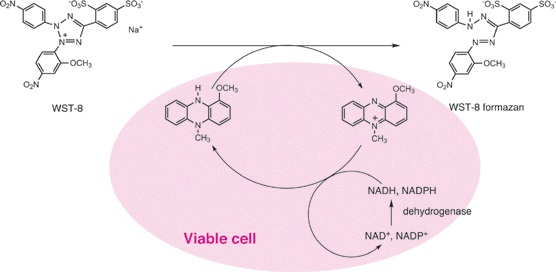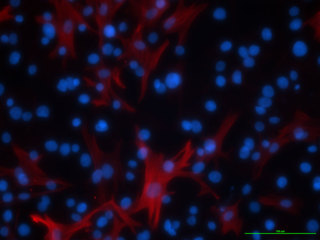Product Description
过氧化物酶标记试剂盒-SH 主要用于制备过氧化物酶标记的 IgG 用于酶免疫测定 (EIA) 和制备过氧化物酶标记的抗原用于竞争性 EIA。 SH 反应性过氧化物酶是该试剂盒的一个组成部分,可与蛋白质或其他分子的硫醇基团发生反应(图 1)。 该试剂盒包含标记过程所需的所有试剂,包括还原剂和储存缓冲液。 SH反应性过氧化物酶与靶分子形成共价键。 还原剂可以在 IgG 分子中产生游离硫醇基团。 当过氧化物酶标记的 IgG 用于 EIA 时,SH 反应性过氧化物酶的标记效率足够高,无需任何标记后纯化过程。如果标记后需要高纯度偶联物,只需使用亲和柱或凝胶渗透柱 . 标记小分子时,可以使用该套件中包含的过滤管去除多余的分子。
Fig. 1 IgG labeling reaction of SH-reactive peroxidase
Precaution♦ The molecular weight of the reduced protein to be labeled with this kit should be greater than 50,000.♦ The molecular weight of the small thiol compound to be labeled with this kit should be smaller than 5,000.♦ IgG or peroxidase-conjugated IgG is always on the membrane of the filtration tube during the labeling process.♦ If the IgG solution contains other proteins with molecular weight larger than 10,000, such as BSA or gelatin, purify the IgG solution prior to labeling peroxidase with this kit. IgG solution can be purified by IgG Purification Kits (not included in this kit).♦ If the IgG solution contains small insoluble materials, centrifuge the solution and use the supernatant for the labeling.
1. K. Inoue, A. Sugiyama, P. C. Reid, Y. Ito, K. Miyauchi, S. Mukai, M. Sagara, K. Miyamoto, H. Satoh, I. Kohno, T. Kurata, H. Ota, A. Mantovani, T. Hamakubo, H. Daida and T. Kodama, “Establishment of a High Sensitivity Plasma Assay for Human Pentraxin3 as a Marker for Unstable Angina Pectoris”, Arterioscler. Thromb. Vasc. Biol., 2007, 27, 161.2. N. Esaki, Y. Ohkawa, N. Hashimoto, Y. Tsuda, Y. Ohmi, R. H. Bhuiyan, N. Kotani, K. Honke, A. Enomoto, M. Takahashi, K. Furukawa, and K. Furukawa, “ASC amino acid transporter 2, defined by enzyme-mediated activation of radical sources, enhances malignancy of GD2-positive small-cell lung cancer.”, Cancer Sci.., 2018, 109, (1), 141.3. G.W.Zhanga, S.J.Lai, Y.Yoshimura, and N.Isobe, “Messenger RNA expression and immunolocalization of psoriasin in the goat mammary gland and its milk concentration after an intramammary infusion of lipopolysaccharide”, Vet. J.., 2014, 202, (1), 89.4. G-W. Zhang, S-J. Lai, Y. Yoshimura, and N. Isobe, “Expression of cathelicidins mRNA in the goat mammary gland and effect of the intramammary infusion of lipopolysaccharide on milk cathelicidin-2 concentration”, Vet. Microbiol.., 2014, 170, (1-2), 125.5. H. Tateno, S. Saito, K. Hiemori, K. Kiyoi, K. Hasehira, M. Toyoda, Y. Onuma, Y. Ito, H. Akutsu, and J. Hirabayashi, “α2–6 sialylation is a marker of the differentiation potential of human mesenchymal stem cells”, Glycobiology., 2016, 26, (12), 1328.6. K. Iizumi, H. Kawasaki, A. Shigenaga, M. Tominaga, A. Otsu, A. Kamo, Y. Kamata, K. Takamori, and F. Yamakura, “Tryptophan nitration of immunoglobulin light chain as a new possible biomarker for atopic dermatitis”, J Clin Biochem Nutr., 2018, 63, (3), 197.7. K. Morioka, K. Fukai, K. Yoshida, R. Yamazoe, H. Onozato, S. Ohashi, T. Tsuda, and K. Sakamoto, “Foot-and-Mouth Disease Virus Antigen Detection Enzyme-Linked Immunosorbent Assay Using Multiserotype-Reactive Monoclonal Antibodies”, J. Clin. Microbiol.., 2009, 47, (11), 3663.8. M. Watanabe, I. Takemasa, N. Kaneko, Y. Yokoyama, E. Matsuo, S. Iwasa, M. Mori, N. Matsuura, M. Monden, and O. Nishimura, “Clinical significance of circulating galectins as colorectal cancer markers”, Oncol. Rep.., 2011, 25, (5), 1217.9. M. Yasunaga, S. Saijou, S. Hanaoka, T. Anzai, R. Tsumura, and Y. Matsumura, “Significant antitumor effect of an antibody against TMEM180, a new colorectal cancer‐specific molecule”, Cancer Sci.., 2019, 110, (2), 761.10. N. Esaki, Y. Ohkawa, N. Hashimoto, Y. Tsuda, Y. Ohmi, R. H. Bhuiyan, N. Kotani, K. Honke, A. Enomoto, M. Takahashi, K. Furukawa, and K. Furukawa, “ASC amino acid transporter 2, defined by enzyme‐mediated activation of radical sources, enhances malignancy of GD2‐positive small‐cell lung cancer”, Cancer Sci.., 2018, 109, (1), 141.11. N. Hashimoto, K. Hamamura, N. Kotani, K. Furukawa, K. Kaneko, K. Honke, and K. Furukawa, “Proteomic analysis of ganglioside‐associated membrane molecules: Substantial basis for molecular clustering”, Proteomics., 2012, 12, (21), 3154.12. N. Kotani, Y. Ida, T. Nakano, I. Sato, R. Kuwahara, A. Yamaguchi, M. Tomita, K. Honke, and T. Murakoshi, “Tumor-dependent secretion of close homolog of L1 results in elevation of its circulating level in mouse model for human lung tumor”, Biochem. Biophys. Res. Commun.., 2018, 501, (4), 982.13. R. Yamashita, N. Kotani, Y. Ishiura, S. Higashiyama, and K. Honke, “Spatiotemporally-regulated interaction between β1 integrin and ErbB4 that is involved in fibronectin-dependent cell migration”, J. Biol. Chem.., 2011, 149, (3), 347.14. T. Noro, E. Oishi, T. Kaneshige, K. Yaguchi, K. Amimoto, and M. Shimizu, “Identification and characterization of haemagglutinin epitopes of Avibacterium paragallinarum serovar C”, Vet. Microbiol.., 2008, 131, (3-4), 406.
Sandwich ELISA
Fig. 2 Sandwich ELISA of human TNF-α detection
Plate: 2 μg/ml anti-human TNF-aantibody (rabbit, polyclonal)-coated high binding platerecombinant human TNF-a: 0-1000 pg/ml PBSTPeroxidase-conjugated anti-human TNF-aantibody: Prepared by Peroxidase Labeling Kit-SH.1μg/mlPBST+blocking reagentSubstrate: TMB peroxidase substrate
References1. K. Inoue, A. Sugiyama, P. C. Reid, Y, Ito, K. Miyauchi, S. Mukai, M. Sagara, K. Miyamoto, H. Satoh, I. Kohno, T. Kurata, H. Ota, A. Mantovani, T. Hamakubo, H. Daida and T. Kodama, Establishment of a High Sensitivity Plasma Assay for Human Pentraxin3 as a Marker for Unstable Angina Pectoris, Arterioscler. Thromb. Vasc. Biol., 2007, 27, 161
Can I use this kit for F(ab”)2?
Yes, please follow the labeling protocol for IgG. The recovery of the conjugate should be over 80%.
Can I use this kit for other proteins or peptides?
Yes, if the molecular weight of the reduced form is greater than 50,000 or less than 5,000, and it has a reactive SH group, or a disulfide group that can be reduced without losing activity. If the molecular weight is greater than 50,000, follow the labeling protocol for IgG, and use 0.5-1 nmol of sample protein for LK09-10. If the molecular weight is less than 5,000, follow the labeling protocol for small molecules. If the molecular weight is between 5,000 and 50,000, contact our customer service at info@dojindo.com or 1-877-987-2667 for more information.
Can I use this kit to label oligopeptides or oligonucleotides?
Yes, if the molecular weights of the oligonucleotide or the oligopeptide are less than 5,000 and they have at least one SH group. Follow the labeling protocol for small molecule.
What is the minimum amount of IgG that can be labeled with LK09-10?
The minimum amount is 50 μg. There is no significant difference in sensitivity and background between 50 μg and 200 μg of IgG. However, even 10 μg IgG can be labeled using 1/5 volume of SH-reactive peroxidase solution at Step 8.
How many peroxidase molecules per reduced IgG are introduced?
The average number of peroxidase molecule per reduced IgG is 1 to 2.
Do I have to use a Filtration tube prior to labeling the protein?
If the protein solution does not contain small molecules with reactive SH groups and the concentration of the protein is 10 mg per ml, or about 70 μM, there is no need to use the Filtration tube. Just mix the sample solution with Solution B and add the mixture to a vial of the SH-reactive peroxidase.
Do I have to use Storage buffer included with the kit?
No, you don’t have to use Storage buffer from the kit. You can choose any kind of buffer appropriate for your experiment. However, the Storage buffer helps to increase the stability of the peroxidase conjugate.
My sample contains small insoluble material. What should I do?
Spin the sample and use the supernatant for labeling.
Does unconjugated SH reactive peroxidase still have a reactive maleimide after the labeling reaction to IgG?
No. Nearly 100% of SH reactive peroxidase is used for the IgG labeling or the small molecule labeling.
Does Storage buffer contain animal products or polymers?
No, Storage buffer does not contain any animal products, polymers, or heavy metal ions.



